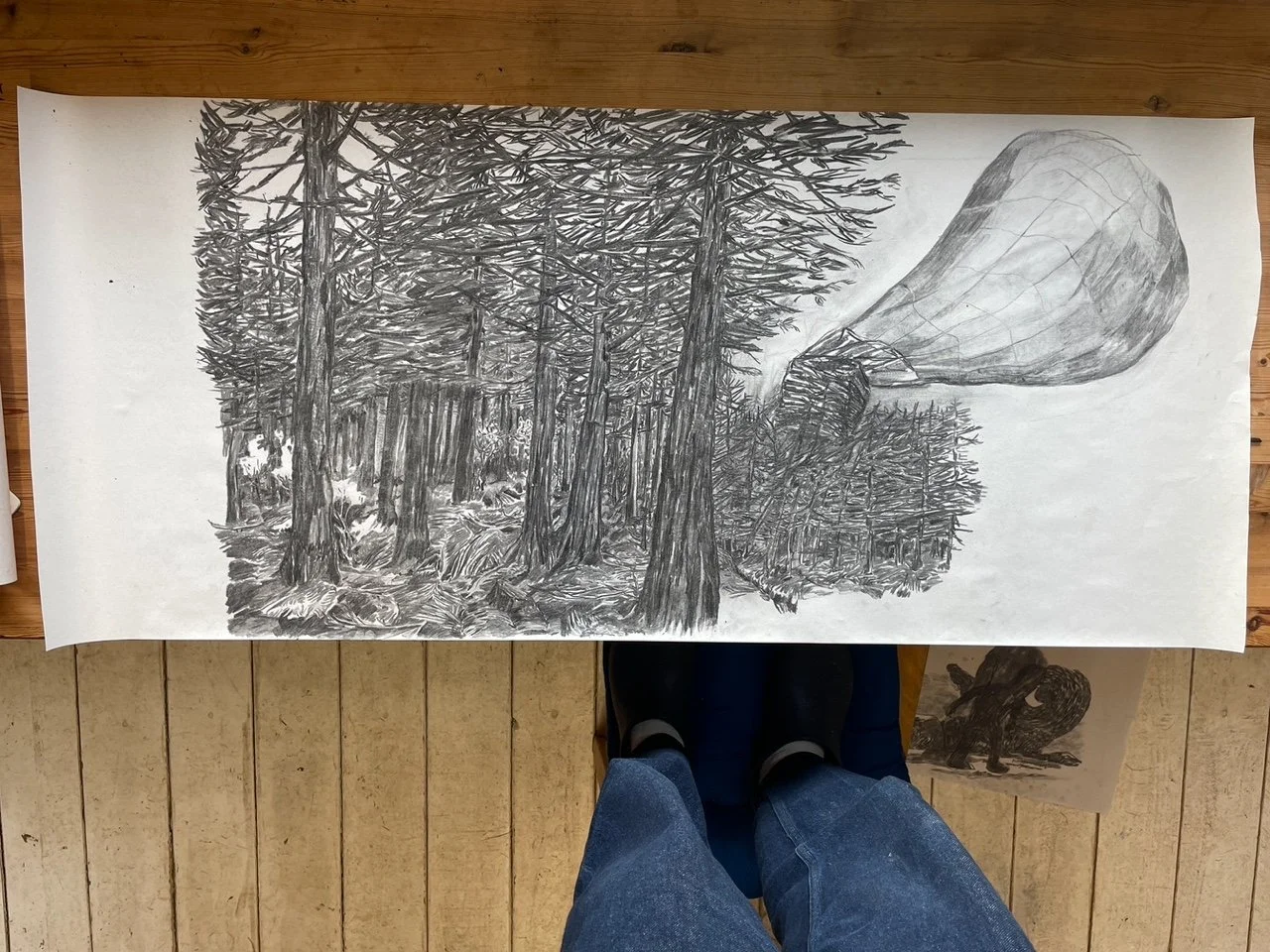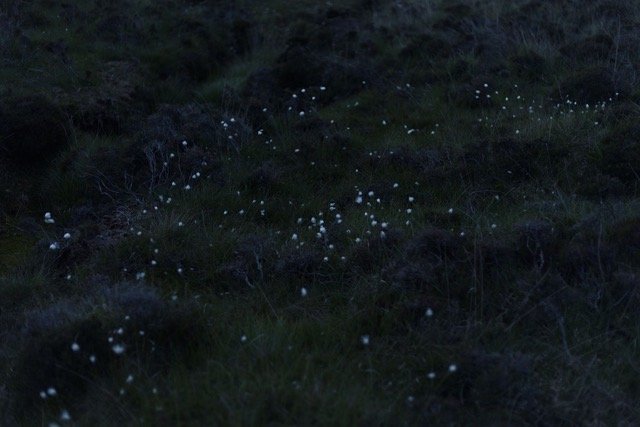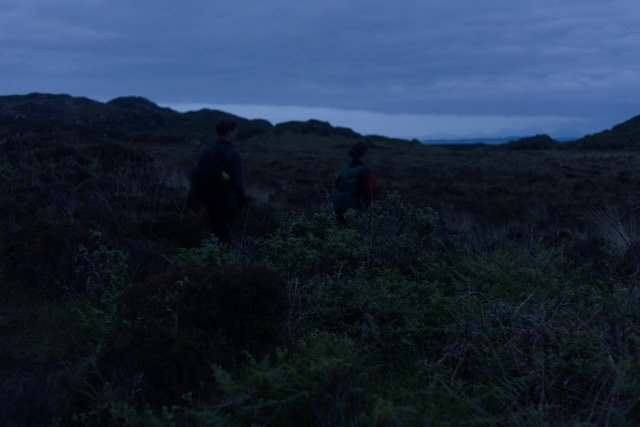Karst-Janneke Rogaar:
20.05.2024 - 3.06.2024
The lapwings are chasing the hooded crows. Their young are somewhere in the field, hidden among the sheep. Many of the sheep have black heads. The crows' calls sound darker here than they do back home. Are they bigger, or does it just seem that way? The proportions here are sometimes hard to judge. I mistake the silhouette of a resting seagull on the horizon for a deer in the distance. A swallow loops above the birch foliage in front of the studio window. Not now, but often, goldfinches dance close to the ground. The teasels in the garden are knee-high, with neither flowers nor seeds yet. Miek told me that the water that gathers at the base of the leaves has medicinal properties. It must stay there for a while, otherwise, it doesn’t work. Brown algae float in the water of the lowest leaves, which seems too old for use. The higher teasel pools look fresher.
Along the path to the compost toilet is a fern. It looks as though it doesn’t stand deep enough, but the dark brown stem rises above the ground, showing all its previous years. The fern stands proudly next to the tall wooden fence leading to the prism. At night, the gate must be closed to keep deer out of the garden. Opposite the fern along the path lies an indeterminate pile of prunings. Near the dogrose on the slope is a young adder basking in the sun. The chickens have nested in a tunnel between the roses and the pig fence that surrounds the vegetable garden. It looks like a fun tunnel. Unfortunately, only the chickens can experience what it’s like to walk through it. The pig fence should keep them out of the vegetable garden, but Mother Hen and her four large chicks ignore the boundary and go in anyway. It’s not difficult. The chicks hide under the rhubarb leaves on the edge of the vegetable beds.
May 22nd
coffee | porridge | charcoal | at work
...
I just need to get started. I have plenty of time.
...
It takes a while to get used to charcoal again. Fun, though. Dirty hands from drawing. I don’t often get that anymore, only when I’m working in the garden.
...
My first drawing is ready. A bit fussy, I think. A kick-start. Don’t judge right away.
What happens when you see the night as a being that comes and goes, comes and goes again?
May 26th
I was planning to finally start working with colour and paint again, but I’m sticking with charcoal. I can’t begin telling with a material until I really know it well—soft, hard, sharp, black, thin, thick, fat, light, and dark.
June 1st - 2nd, Knockvologan-Tireragan
Night walk. At dusk, everything white lights up. Pay attention, because it will escape you just like that.
9:30 p.m. First, you see the hawthorn—the flowering one—like an alien among other trees. If you walk further, there’s a field full of white, swaying dots—a sparkling field thanks to the cotton grass. A little later, a stick lies in the middle of the path. The wand gives light in the darkness. So does the path, lighting up because of the stones, the dry flat grass in the middle, and the stems of the heather at the sides. They are grey-white, silver-shining. Near the birches, walking among bracken, we pass through a tunnel of moths. They dance around and in front of us. It seems like a party. Something dark and tiny moves on the path suddenly. I almost step on a toad—its skin absorbs all the light. Right next to the path, the toad takes cover under the dark grass. We share these paths with other animals. They find them more convenient than wobbling across peat lumps. Funny how the toad steps aside to let us pass.
The dove with the long beak turns out to be a woodcock. Because of the light from the bird app, we see nothing for a while, but that soon passes. The next day in the pub, we hear from birder Peter that the cricket we heard in the distance is the rare grasshopper warbler.
We reach the beach, which is much lighter than everything around it. Dark rocks and the forest we just came out of. Even darker islands in the sea. We hear the surf moving, rolling from right to left. Rutger takes a picture with the self-timer, in which all the depth is gone. I’m out with two gnomes. Now that we’ve decided to head back, the forest seems even darker.
23:45
As soon as we step off the beach into the woods, we begin to discern things again. The different plants vary in shades of dark. The stones on the path are conveniently white, as if deliberately designed so. We smell sweet bushes and hear the tawny owl, otherwise, it’s very quiet. All the colour has gone, and the outlines are blurred.
00:26
When you can’t see depth, it’s much harder to walk. We marvel at how automatic it becomes in daylight. I step in the wrong place and sink to my groin in the peat muck.
01:15
As soon as we pass through the gate, the nature reserve behind us feels empty and deserted. Suddenly, it’s a place you don’t want to be in—almost grim. The proximity of a safe house tilts the night.
In some of the drawings I made here, you remain a spectator. In others, you are allowed to "step in." If you can enter the drawing, it’s more exciting, especially in the one with the trees, the path, and the fence. The skin of the night seems more porous. Things have no hard boundaries. In truth, the world doesn’t consist of separate elements. It’s such a shame that our time, or the West, sees everything as separate. I’d like to let go of that. Illustrations for children’s books rarely contain unclear interstices—everything has to be clear because children like that. Is that really the case? I’m going to let it go. Add more things that raise questions and create situations on paper where the answer isn’t immediately given.
...
I now have a plan.
It’s much closer than I thought.
It may also change.














